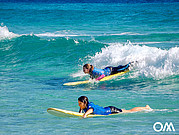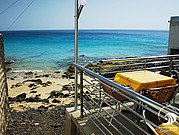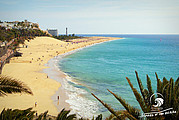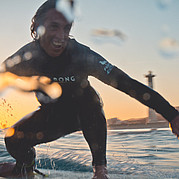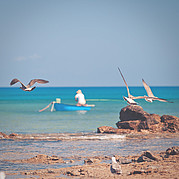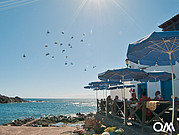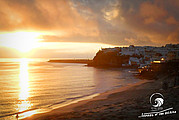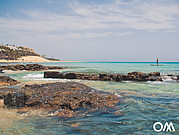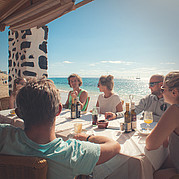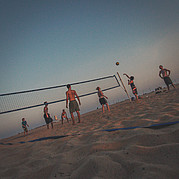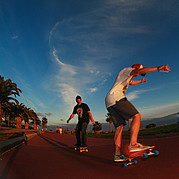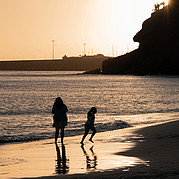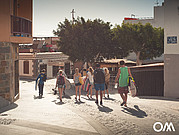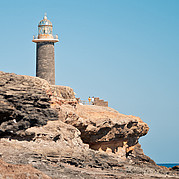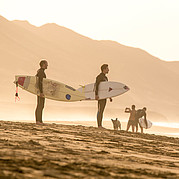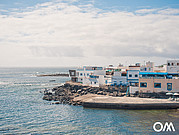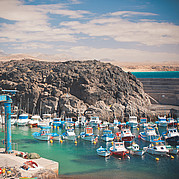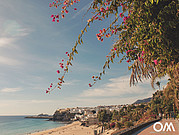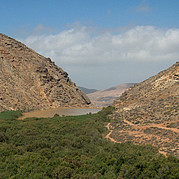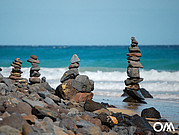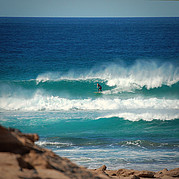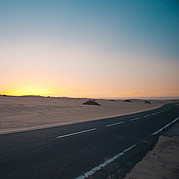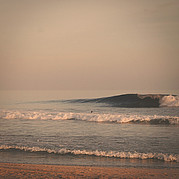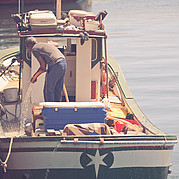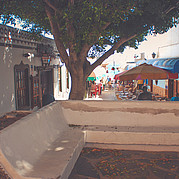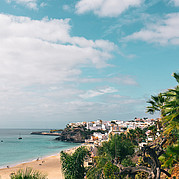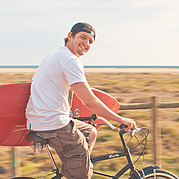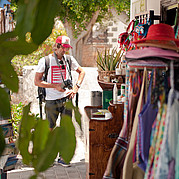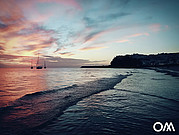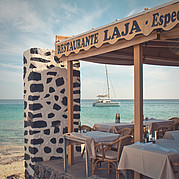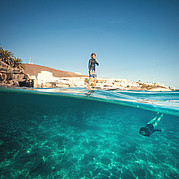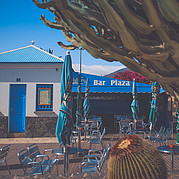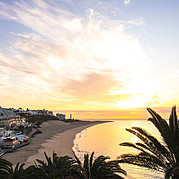Surfing on the east coast in the south of Fuerteventura
When the trade winds are strong enough, there are waves all along the east coast of Fuerteventura's southern peninsula. If this wind blows for a period of at least one and a half days or longer, the waves on Fuerteventura's east coast become bigger, stronger and more orderly. The two most famous surf spots on the east coast are the beach below the small settlement of Esquinzo and of course the beach section "El Pozo" in front of the lighthouse of Jandia.
However, there are several other beaches on the east coast of Fuerteventura. You can surf on them if the trade winds are strong enough. The special thing about these beaches is that the local wind is offshore. The small breaking waves are particularly clean or orderly and therefore easier to surf.
Directions to the beaches of the east coast of Fuerteventura
The east coast of Fuerteventura's southern peninsula begins at Costa Calma and ends at the lighthouse in Jandia. The stretch of beach between the Jandia lighthouse and Morro Jable already points south and therefore to the south coast of the island. There are several fine beaches and small bays along these 20 kilometres. The motorway runs parallel to the coast and there are several descents that take you to the water.
In the desert-like area between La Pared and Costa Calma, there is only one other exit besides the one to Costa Calma, which leads to the large tidal lagoon. Further south of the lagoon, the mountains of Fuerteventura's southern peninsula begin. From here there is a country road that winds in serpentines along the east coast. If you want to discover the many small beaches and beautiful bays of the east coast, you should change from the motorway to the country road.
From the approx. 15 kilometre long country road, there are various junctions to the beach sections and bays of the southern east coast of Fuerteventura. You can see many of the waves on the east coast from the elevated road. Some of the turn-offs to the beach are unpaved. Most of these dirt roads are not very long. Nevertheless, you should drive carefully on them. Many car rental companies exclude damage that happens on unpaved roads from the renter's insurance coverage.
To get directly to the Esquinzo surf spot, drive the last few metres on a gravel road. Alternatively, you can park in the village of Esquinzo and walk to the beach. If you continue on the country road, you will drive the last kilometres to Jandia on the motorway again. The motorway ends at a roundabout with sculptures of small children in the middle. Here there is another turn-off to the beach. If you continue to follow the road, you will come to Jandia. Waves break on different parts of the beach. The best known is directly in front of the Jandia lighthouse and is called "El Pozo". You can easily find a parking place here.
The waves on the east coast of Fuerteventura
The course and width of the beach on Fuerteventura's east coast changes greatly between Costa Calma and Jandia, located at the southern end. The landscape behind the beach also changes. In Costa Calma and in the desert-like landscape further south, the island is comparatively flat. At the end of the "Istmo de La Pared" and the large tidal lagoon of "Sotavento", the landscape changes. Here begins a mountain range whose peaks include Fuerteventura's highest mountain. Just as the surrounding landscape, the length and width of the individual beach sections change as the east coast progresses, so too does the shape and force of the waves on the individual beaches.
In the northern part of the east coast near Costa Calma and the large lagoon, the wind is stronger due to the comparatively flat landscape behind the beaches. The waves usually break more gently here than at other beaches further south. You can only surf the breaking waves here with a surfboard with a lot of volume - malibus and longboards are the first choice here. If the waves get big, a thick fishboard will also work very well. In the southern course of the east coast, to which the old country road runs parallel, the waves are a bit stronger than at Costa Calma. Thanks to the mountains in the background, the wind is also slightly weaker here. At beaches like Esquinzo, you can swap your Malibu for a fishboard a little more often.
With the right wave and wind direction, the waves in front of the lighthouse in Jandia are the strongest. On good days, the wind waves from "El Pozo" are just as good and better than waves on the beaches of the west coast. That's why many good local surfers surf here quite regularly with their shortboards.
In what conditions do you surf on the east coast of Fuerteventura?
For surfable waves to break on the southern east coast of Fuerteventura, the wind must come from the north-east. The trade wind, which is typical for Fuerteventura, usually has exactly the right angle from the north-east. If this trade wind blows strongly enough and over a period of more than one day, waves break on the east coast of Fuerteventura's southern peninsula. The special thing is that although the waves are created by wind, the same wind is offshore directly on the beach, which makes the waves very clean and easier to surf.
The strength and duration of the wind ultimately determine the wave height on Fuerteventura's east coast. Usually, the longer the wind blows, the bigger the waves. In addition, the force of the waves, which is measured in seconds, also increases the longer the wind lasts. It is also called the period and describes the distance between the individual waves. This makes the waves more organised and easier to surf.
Depending on whether you are a surf beginner or an advanced surfer, you choose the tide level that suits your level. Beginners are more likely to hit the water at low tide on most east coast beaches. For advanced surfers, the unbroken waves are often better at high tide.
What to look out for when surfing on the east coast of Fuerteventura?
The beaches and waves on the east coast in the south of Fuerteventura are barely dangerous. Currents are much weaker than comparable currents on the west coast of the island. There are almost no currents that pull surfers out to sea. Mostly there is a current parallel to the coast from north to south. This parallel current becomes stronger the bigger and stronger the waves are. This current is only dangerous for surfers who do not orient themselves to the land. They do not notice how far they may have already moved away from the spot where they entered the water. The consequence can be a longer walk back to the beach.
On days with rather smaller waves, you should always be aware that the waves break in relatively shallow water. In the last section of some waves, the water is only knee-deep. This is not super dangerous because the bottom is soft sand. Nevertheless, you should be careful when getting off the surfboard. Some waves on the east coast break very close to the shore at high tide. In Esquinzo, careless surfers can get caught in the large stones at the northern end of the bay. At the beach section "El Pozo", the waves can sometimes break very violently onto the beach at high tide.
